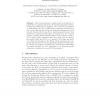Free Online Productivity Tools
i2Speak
i2Symbol
i2OCR
iTex2Img
iWeb2Print
iWeb2Shot
i2Type
iPdf2Split
iPdf2Merge
i2Bopomofo
i2Arabic
i2Style
i2Image
i2PDF
iLatex2Rtf
Sci2ools
ICCS
2009
Springer
2009
Springer
A Massively Parallel Architecture for Bioinformatics
Abstract. Today’s general purpose computers lack in meeting the requirements on computing performance for standard applications in bioinformatics like DNA sequence alignment, error correction for assembly, or TFBS finding. The size of DNA sequence databases doubles twice a year. On the other hand the advance in computing performance per unit cost only doubles every 2 years. Hence, ingenious approaches have been developed for putting this discrepancy in perspective by use of special purpose computing architectures like ASICs, GPUs, multicore CPUs or CPU Clusters. These approaches suffer either from being too application specific (ASIC and GPU) or too general (CPU-Cluster and multicore CPUs). An alternative is the FPGA, which outperforms the solutions mentioned above in case of bioinformatic applications with respect to cost and power efficiency, flexibility and communication bandwidths. For making maximal use of the advantages, a new massively parallel architecture consisting of l...
| Added | 26 May 2010 |
| Updated | 26 May 2010 |
| Type | Conference |
| Year | 2009 |
| Where | ICCS |
| Authors | Gerd Pfeiffer, Stefan Baumgart, Jan Schröder, Manfred Schimmler |
Comments (0)

